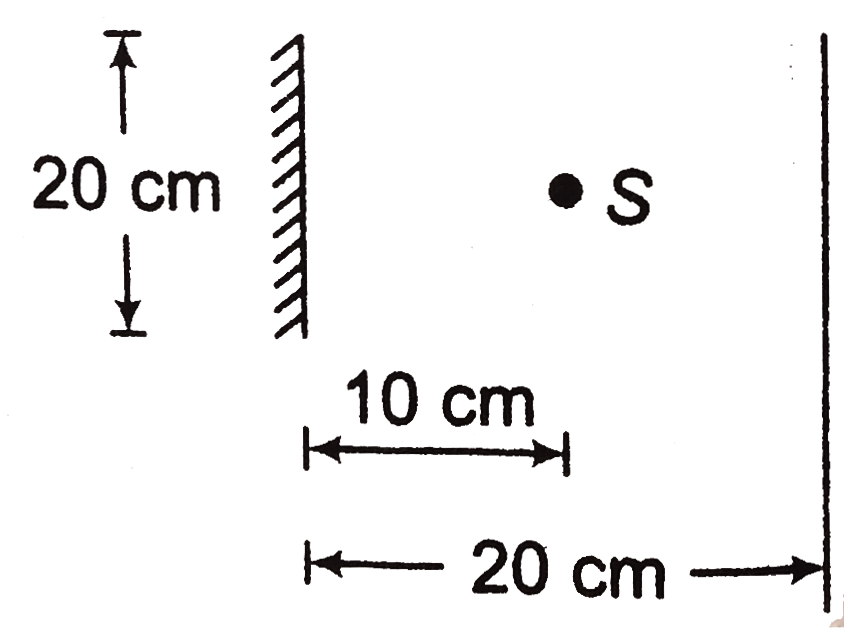A thin prism of angle 6∘ made up of glass of refractive index 1.5 is combined with anorher prism made up of glass of refractive index 1.75 to produce dispersion without deviation. The angle of second prism is
7∘
9∘
4∘
5∘
The correct Answer is:C
To solve the problem of finding the angle of the second prism that, when combined with the first prism, produces dispersion without deviation, we can follow these steps:
Step 1: Understand the Given Data
We have:
- Angle of the first prism (A1) = 6 degrees
- Refractive index of the first prism (μ1) = 1.5
- Refractive index of the second prism (μ2) = 1.75
- We need to find the angle of the second prism (A2).
Step 2: Set Up the Condition for Dispersion without Deviation
For two prisms to produce dispersion without deviation, the following condition must hold:
δ1−δ2=0
This implies:
δ1=δ2
Using the formula for deviation for a thin prism, we have:
δ=(μ−1)⋅A
Thus, for the two prisms:
(μ1−1)⋅A1=(μ2−1)⋅A2
Step 3: Substitute the Known Values
Substituting the values we have:
(1.5−1)⋅6=(1.75−1)⋅A2
This simplifies to:
0.5⋅6=0.75⋅A2
3=0.75⋅A2
Step 4: Solve for A2
Now, we can solve for A2:
A2=30.75
Calculating this gives:
A2=3×10075=30075=4 degrees
Final Answer
The angle of the second prism (A2) is 4 degrees.
---
We have:
- Angle of the first prism (A1) = 6 degrees
- Refractive index of the first prism (μ1) = 1.5
- Refractive index of the second prism (μ2) = 1.75
- We need to find the angle of the second prism (A2).
For two prisms to produce dispersion without deviation, the following condition must hold:
δ1−δ2=0
This implies:
δ1=δ2
Using the formula for deviation for a thin prism, we have:
δ=(μ−1)⋅A
Thus, for the two prisms:
(μ1−1)⋅A1=(μ2−1)⋅A2
Substituting the values we have:
(1.5−1)⋅6=(1.75−1)⋅A2
This simplifies to:
0.5⋅6=0.75⋅A2
3=0.75⋅A2
Now, we can solve for A2:
A2=30.75
Calculating this gives:
A2=3×10075=30075=4 degrees
The angle of the second prism (A2) is 4 degrees.
Topper's Solved these Questions
- RAY OPTICSBook:DC PANDEY ENGLISHChapter:RAY OPTICSExercise:medical entrance special format question
Explore 22 Videos
- RAY OPTICSBook:DC PANDEY ENGLISHChapter:RAY OPTICSExercise:Medical entrance gallary
Explore 73 Videos
- RAY OPTICSBook:DC PANDEY ENGLISHChapter:RAY OPTICSExercise:Checkpoint 9.7
Explore 10 Videos
- NUCLEIBook:DC PANDEY ENGLISHChapter:NUCLEIExercise:C MADICAL ENTRANCES GALLERY
Explore 46 Videos
- REFLECTION OF LIGHTBook:DC PANDEY ENGLISHChapter:REFLECTION OF LIGHTExercise:Subjective
Explore 9 Videos
Similar Questions
Assertion The formula connecting u, v and f for a spherical mirror is valid only for mirrors sizes which are very small compared to their radii of curvature.
Reason Laws of reflection are stricity valid for plane surface, but not for large spherical.
View SolutionTwo identical glass (μg=3/2) equi- convex lenses of focal length f each are kept in contact. The space between the two lenses is also filled with water (μg=4/3). The focal length of the combination is
View SolutionFor the myopia defect in eye, it can be removed by
View SolutionThe half-life of a radioactive substance is 30 minutes, The time (in minutes) taken between 40% decay and 85% decay of the same radioactive substance is.
View SolutionA point source of light S is placed at a distance 10 cm in front of the centre of a mirror of width 20 cm suspended vertically on a wall. An insect walks with a speed 10cm/s in front of the mirror along a line parallel to the mirror at a distance 20 cm from it as shown in figure. find the maximum time during which the insect can see the image of the source S in the mirror.

View SolutionA prism is made of glass of refractive index 1.5. If the angle of minimum deviation is equal to the refracting angle of the prism, calculate the angle of the prism.
View SolutionA thin prism of angle 15∘ made of glass of refractive index μ1=1.5 is combined with another prism of glass of refractive index μ2=1.75. The combination of the prism produces dispersion without deviation. The angle of the second prism should be
View SolutionA thin prism having refracting angle 10^(@) is made of glass of refracting index 1.42 . This prism is combined with another thin prism of glass of refractive index 1.7 . This combination produces dispersion without deviation. The refracting angle of second prism should be :
View SolutionA thin prism of angle 15∘ made of glass of refractive index μ1=1.5 is combined with another prism of glass of refractive index μ2=1.75. The combination of the prisms produces dispersion without deviation. The angle of the second prism should be
View SolutionA thin prism of angle 6∘ made up of glass of refractive index 1.5 is combined with anorher prism made up of glass of refractive index 1.75 to produce dispersion without deviation. The angle of second prism is
View Solution1.42 अपवर्तनांक के काँच से बने, एक पतले प्रिज्म का अपवर्तक कोण 10∘ है। इस प्रिज्म को 1.7 अपवर्तनांक के काँच से बने एक अन्य पतले प्रिज्म से जोड़ दिया जाता है तो, दूसरे प्रिज्म का अपवर्तक कोण जाना चाहिए :
View Solutionकाँच से निर्मित एक पतले प्रिज्म से उतपन्न न्यूनतम विचलन कोण 4∘ है। प्रिज्म कोण ज्ञात कीजिये। काँच का अपवर्तनांक 1.5 है।
View Solution4∘ प्रिज्म कोण वाले और 1⋅54 अपवर्तनांक के काँच का बना एक पतला प्रिज्म एक अन्य पतले प्रिज्म के साथ , जिसके काँच का अपवर्तनांक 1⋅72 हैं , विचलन रहित विक्षेपण उत्पन्न करने के लिए संयोजित किया जाता हैं | दूसरे प्रिज्म का कोण होगा -
View SolutionA thin prism of angle 15^(@) made of glass of refractive index mu_(1) = 1.5 is combined with another prism of glass of refractive index mu_(2) = 1.75 . The combination of the prism produces dispersion without deviation, The angle of the second prism should be
View SolutionA thin glass prism of angle 6∘ of refractive index 1.5 is combined with another glass prism of refractive index 1.6 to produce dispersion without deviation. What is the angle of the second prism ?
View Solution
